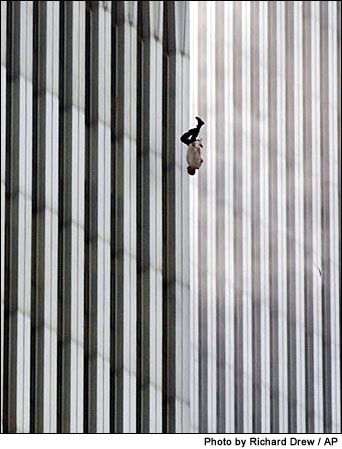The picture above (“Richard Drew,” Peter Howe, Digital Journalist) clearly depicts a man plummeting to his demise because he jumped out of a window of one of the towers. This could lead one to believe that he was trying to escape from the flames, and made the choice to jump. This picture has actually caused quite a controversy among the newspapers that published this picture and the people who read those newspapers (The Memphis Commercial Appeal and the Fort Worth Star Telegram). The argument is basically that they (the readers) do not want to see a picture that is so disturbing, something that might disrupt their way of life. The fact that these people cannot hide from is that September 11th was a disturbing event, and all things considered, cannot be made lightly. We, as a nation, may want to hide from the world, but it is just not possible.
Newspapers around the world have published pictures in their papers of heroic firefighters, policemen, and rescue workers. These are undeniably symbols of the “silver lining” of September 11th. However, “there are indications of selective perception of what is viewed, namely that audiences tend to identify with that which reinforces their existing beliefs,” (“The Role of the Media in Promoting Images of Disability -- Disability
as Metaphor: The Evil Crip,” Marilyn Dahl, Canadian Journal of Communication). In other words, people only see what they want to see. A block of the negative things (the dying people) has been implanted in our perception of what happened on September 11th. The controversy of this picture is the epitome of that observation. The picture itself depicts all that we want to shield ourselves from. The actions of the terrorists are real, and it is time to wake up and realize this.
I, myself, am glad this picture was put out into the media. It shows people that there was more to September 11th than two buildings falling to the ground. When we were watching the events unfold, we became witnesses to the murder of thousands of people. We were all so glad that it was not us who died in that horrific event, that we try to stop images, like the one above, from haunting our minds. However, the image above was real, and there is nothing we can tell ourselves to change that. That man falling to his demise was a real man. He was important to someone and as long as it was not us or someone we knew, we remain comfortable in our protective bubble.
Imagine that you are this man. You have seen the buildings on fire and the smoke filling up the rooms. You have two choices: jump or be burned alive. You choose to jump, just as the man did. The point of this is that you had a choice, and you decided to make it because you would never have another chance to make a decision again, and you took the opportunity. This is what the man in the picture had to do. Now, compare this to our “protective bubble,” and it is plain to see that the two do not even begin to compare. We are afraid of seeing, hearing, and thinking about these things, but here is this man who lived it.
This man is conveying a message that tells us that we are never completely safe from the horrors of the world. He may have been living in the same protective bubble that many of us live in today, but on that day, knew that you cannot shelter yourself from everything in the world, no matter what you do. The events of September 11th came out of left field and were not entirely expected. This man was one of many who was caught off-guard, and paid with his life. This kind of powerful message can make one think that time is precious and wasting time trying to ward off these “bad things” is not helpful, if not hurtful.
We have all watched over and over again the terrors of September 11th. This may be part of the reason that we want to stop these images from invading our minds. The point is that we get the chance to continue on with our lives, whereas the victims will never again have the opportunity to do so. It is fine if we are scared and want life to go on normally. The thing is that after September 11th, nothing was left “normal.” Everything has changed and it needs to be recognized as such. It is good to know that the towers fell, but it is even better to know that there were ones who fell along with it, people like the man in the picture. Empathy and understanding can be used to help us relate what happened. To put ourselves in that man’s shoes might change our viewpoints and even if it was scary, it can further help us to unite in compassion for one another. Fear might be the largest crippler in the quest for tolerance. In accordance with this notion, when a picture of September 11th, such as the one above, is shown, instead of dread for the unknown, sympathy for a fellow American should take part. If this were to happen, we (as a nation) will be stronger and ready for the enemy, for we will have fought our biggest enemy, fear. After all, to live by the quote, “The only thing we have to fear is fear itself” (President Franklin D. Roosevelt), may be to live in unity and harmony.
Works Cited:
Howe, Peter. “Richard Drew.”
The Digital Journalist 2001. 16 October 2002
www.digitaljournalist.org/issue0110/drew.htm
Dahl, Marilyn. “The Role of the Media in Promoting Images of Disability -- Disability
as Metaphor: The Evil Crip
Canadian Journal of Communication. Volume 18, Number 1, 1993. 23
October 2002
http://www.wlu.ca/~wwwpress/jrls/cjc/BackIssues/18.1/dahl.html
Schulman, Neil. “The only thing we have to fear is fear itself…”
The Sierra Times Trading Post. 20 September 2001. 23 October 2002.
http://www.sierratimes.com/archive/vanity2001/jneil.htm
